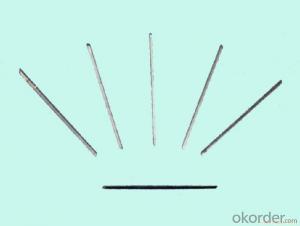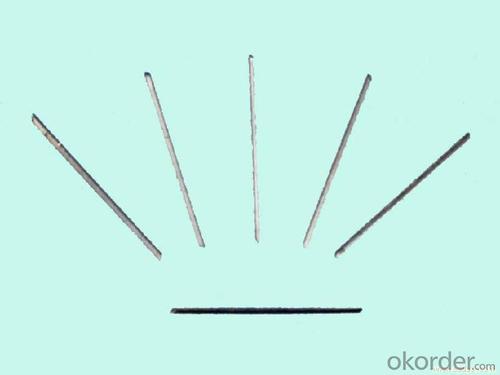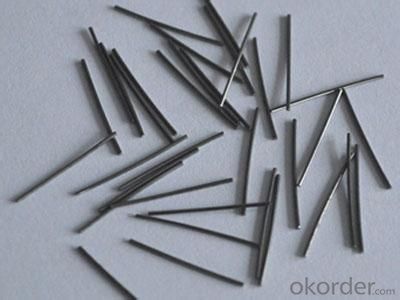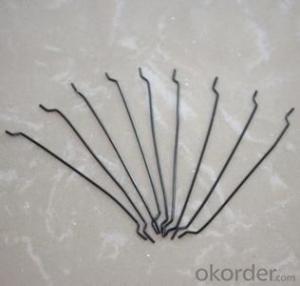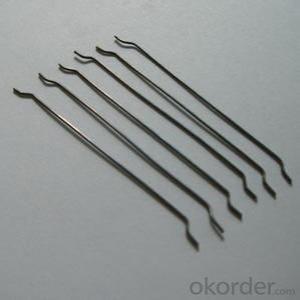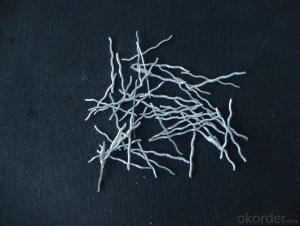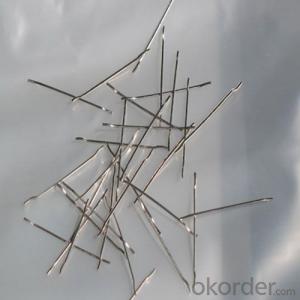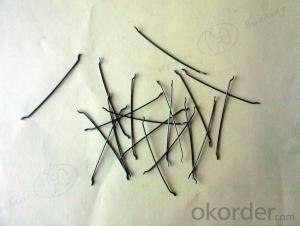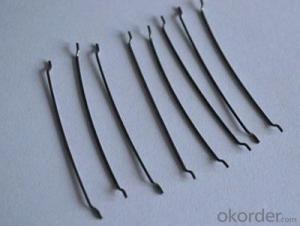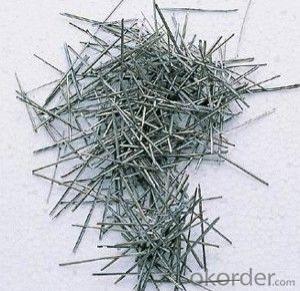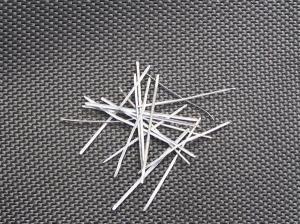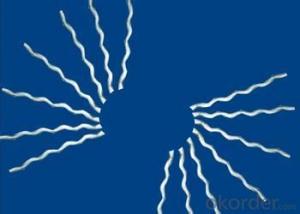Melt Extract Stainless Steel Fiber - Straight Type Steel Fiber from CNBM China
- Loading Port:
- Tianjin
- Payment Terms:
- TT OR LC
- Min Order Qty:
- 1000 kg
- Supply Capability:
- 30000 kg/month
OKorder Service Pledge
OKorder Financial Service
You Might Also Like
Quick Details
Place of Origin: Jiangsu, China (Mainland)
Model Number: HT-ST
Material: Steel
Specifications
ISO 9001 certificated
2.70% for Europe, Middle Asia, America market
3.Have the most number of steel fiber machine in china
1. Material: low carbon steel wire or stainless steel
2.Diameter: 0.4mm-1.0mm
3.Length: meet your requirements
4.tensile strength >1000Mpa
6.Feature: excellent tensile,high tenacity,against cracking,impact and fatigue
7.Uses: highway road surface,tunnel,building,airport road surface and so on .
Straight Steel Fiber
1.ISO 9001 certificated
2.70% for Europe, Middle Asia, America market
3.Have the most number of steel fiber machine in china
Picture
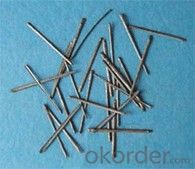
Steel fiber straight type
FAQ
certificated: ISO 9001
Technical advantages of Daye steel fiber:
A. Improve mechanical performance of concrete
B. Provide uniform distribution throughout concrete with excellent mixing
C. No balling or caking by adopt correct mixing method
D. Reduce concrete volume
E.Save construction time and cost
F.Reduce excavation volume
G.Available for jointless floor.
- Q: Can melt extract stainless steel fiber be used in basement walls?
- Yes, melt extract stainless steel fiber can be used in basement walls. It is commonly used as a reinforcement material to improve the structural integrity and durability of concrete. The stainless steel fibers enhance the flexural and tensile strength of the concrete, making it an ideal choice for basement walls that require added strength and resistance to cracking.
- Q: What is the effect of melt extract stainless steel fiber on the crack resistance of concrete?
- The crack resistance of concrete is significantly impacted by the utilization of melt extract stainless steel fiber. To enhance the mechanical properties of concrete, including crack resistance, stainless steel fibers are incorporated into concrete mixes. One of the primary advantages of using melt extract stainless steel fiber is its capacity to enhance the tensile strength and ductility of concrete. These fibers act as reinforcement within the concrete matrix, effectively connecting any cracks that may arise due to shrinkage or external loads. This connection prevents the spread of cracks and enhances the overall crack resistance of the concrete. The addition of stainless steel fibers also enhances the overall durability of concrete. Thanks to their resistance to corrosion, these fibers can endure harsh conditions such as exposure to chemicals, moisture, and temperature fluctuations. This durability helps to maintain the structural integrity of the concrete and reduces the likelihood of cracks forming over time. Furthermore, melt extract stainless steel fibers also contribute to the concrete's energy absorption capacity. During loading, these fibers absorb energy and distribute it throughout the structure, thereby reducing stress concentration in specific areas and minimizing crack formation and propagation. To summarize, the inclusion of melt extract stainless steel fiber significantly improves the crack resistance of concrete. These fibers enhance the tensile strength, ductility, and durability of the material, effectively connecting cracks and preventing their spread. By enhancing crack resistance, stainless steel fibers contribute to the overall longevity and performance of concrete structures.
- Q: Does melt extract stainless steel fiber improve the resistance to chloride penetration of concrete?
- Concrete structures in coastal or industrial areas, where chloride ions are present in high concentrations, are particularly susceptible to corrosion caused by chloride penetration. However, the resistance of concrete to chloride attack can be improved by incorporating melt extract stainless steel fiber into the concrete mix. This addition creates a reinforcement network that enhances the durability and resistance of the concrete. The stainless steel fibers act as a physical barrier, reducing the permeability and ingress of chloride ions into the concrete matrix. This, in turn, helps to prevent or delay the onset of corrosion, prolonging the lifespan of the concrete structure. Moreover, the stainless steel fibers also contribute to the overall strength and toughness of the concrete, further enhancing its performance and durability. Hence, the utilization of melt extract stainless steel fiber in concrete can effectively improve its resistance to chloride penetration and increase the longevity of concrete structures.
- Q: How does melt extract stainless steel fiber improve the durability of sprayed concrete?
- Melt extract stainless steel fiber improves the durability of sprayed concrete by enhancing its strength and resistance to cracking. The fibers act as reinforcement, providing additional tensile strength to the concrete. This helps to prevent the formation and propagation of cracks, increasing the overall durability and lifespan of the sprayed concrete.
- Q: How does melt extract stainless steel fiber improve the resistance to spalling in concrete?
- Melt extract stainless steel fibers improve the resistance to spalling in concrete by enhancing the overall strength and durability of the material. These fibers act as reinforcement, preventing the propagation of cracks and reducing the risk of concrete spalling. Additionally, they enhance the bond between the concrete matrix and the fibers, resulting in increased resistance to spalling caused by thermal stresses, impact, or other external factors.
- Q: What is the effect of melt extract stainless steel fiber on the modulus of brittleness of concrete?
- The inclusion of melt extract stainless steel fiber has a significant impact on the brittleness modulus of concrete, reducing it greatly. In order to enhance the toughness and ductility of concrete, stainless steel fibers are usually incorporated into concrete mixes. These fibers are dispersed throughout the concrete matrix, acting as reinforcement and promoting a more even distribution of stress. As a result, the concrete becomes more resistant to cracking and exhibits increased flexural strength. Furthermore, the addition of stainless steel fibers aids in the control and limitation of crack propagation within the concrete, effectively decreasing its brittleness. These fibers act as a barrier, preventing cracks from spreading further and thus contributing to the durability and resilience of the material. Ultimately, this improved crack resistance and enhanced ductility contribute to an increase in the brittleness modulus of concrete. Melt extract stainless steel fibers, in particular, are renowned for their exceptional tensile strength and resistance to corrosion. This makes them an ideal choice for reinforcing concrete structures in harsh environments, such as coastal areas or those exposed to chemicals. By incorporating melt extract stainless steel fibers into concrete, the overall performance and longevity of the material are greatly improved. To summarize, the introduction of melt extract stainless steel fibers into concrete results in a significant reduction in its brittleness modulus. This is achieved by enhancing the material's toughness, ductility, and crack resistance. The end result is a concrete that is more durable and resilient, capable of withstanding higher levels of stress and strain without experiencing failure.
- Q: Can melt extract stainless steel fiber be used in precast concrete beams or columns?
- Precast concrete beams or columns can indeed utilize melt extract stainless steel fiber. It is a popular choice for reinforcing concrete structures because of its exceptional strength and durability. By incorporating stainless steel fiber, the flexural and tensile strength of precast concrete beams and columns can be significantly improved, resulting in greater resistance to cracking and overall performance enhancement. Moreover, stainless steel fibers possess outstanding resistance to corrosion, making them highly suitable for environments where concrete structures are subjected to moisture or chemicals. Ultimately, the utilization of melt extract stainless steel fiber in precast concrete beams or columns contributes to their prolonged lifespan and enhanced structural integrity.
- Q: Is melt extract stainless steel fiber suitable for use in industrial flooring?
- Yes, melt extract stainless steel fiber is suitable for use in industrial flooring. This type of fiber is specifically designed for applications that require high strength and durability, making it ideal for industrial environments. It can withstand heavy loads, impact, and abrasion, ensuring long-lasting performance in areas with high foot and vehicle traffic. Additionally, stainless steel fibers are resistant to corrosion, which is important in industrial settings where exposure to chemicals or moisture is common. The melt extract process creates fibers with uniform distribution and excellent bonding properties, ensuring optimal reinforcement throughout the flooring material. Overall, melt extract stainless steel fiber is a reliable choice for industrial flooring due to its strength, durability, and resistance to corrosion.
- Q: How does melt extract stainless steel fiber improve the flexural toughness of concrete?
- Melt extract stainless steel fiber improves the flexural toughness of concrete by enhancing its resistance to cracking and increasing its ductility. The fibers act as reinforcement, distributing stress more evenly throughout the concrete matrix and bridging micro-cracks that may occur. This results in improved flexural strength and increased resistance to bending and other forms of mechanical loading, ultimately enhancing the overall durability and performance of the concrete structure.
- Q: Can melt extract stainless steel fiber be used in asphalt or bitumen?
- Yes, melt extract stainless steel fiber can be used in asphalt or bitumen. Stainless steel fibers are commonly used as a reinforcement material in asphalt or bitumen to improve its strength, durability, and resistance to cracking. The fibers are added to the mix during the manufacturing process, where they are evenly distributed to provide reinforcement throughout the entire asphalt or bitumen mixture. The addition of stainless steel fibers helps to enhance the overall performance and lifespan of the asphalt or bitumen, making it more resistant to fatigue and cracking caused by heavy traffic or other external factors.
Send your message to us
Melt Extract Stainless Steel Fiber - Straight Type Steel Fiber from CNBM China
- Loading Port:
- Tianjin
- Payment Terms:
- TT OR LC
- Min Order Qty:
- 1000 kg
- Supply Capability:
- 30000 kg/month
OKorder Service Pledge
OKorder Financial Service
Similar products
Hot products
Hot Searches
Related keywords
